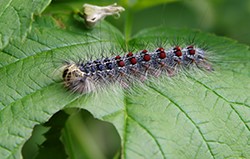General Care Tips
- Tree roots need oxygen to help the tree grow and be healthy, and they can suffocate if too much material is placed over them. Do not place more than 3 or 4 inches of material (such as soil or mulch) over top of the roots.
- Avoid getting close to the tree trunk with tools such as lawn mowers, shovels and weed whackers to prevent the trunk from being cut by accident.
- Do not place hard surfaces such as paving inside the tree canopy; this will damage the roots and can start to kill the tree slowly. Contact the Town should you wish to expand your driveway.
- Do not prune or remove the top stem or branches of the tree; this can change its structure and make it hazardous or unhealthy. Contact the Town to prune a boulevard tree.
- Small sucker stems that grow right out from the lower trunk can be removed. These small stems can be cut off and will help the tree to grow using its upper larger branches only.
Invasive Species and Infestations
Emerald Ash Borer
An insect called the Emerald Ash Borer has been attacking Ash trees in southern Ontario for several years. The Town has a program to review and treat its Ash trees though injections into the trunks to try and protect them from the insect. The most recent treatment occurred in 2020. Other Ash trees that have suffered too much canopy loss and cannot recover are being removed.
Spongy (Gypsy) Moth Caterpillars
The Town has looked into Spongy Moth (previously called European Gypsy Moth or by it's scientific name Lymantria Dispar dispar/LDD) infestation and consulted professional Arborists. The Spongy Moth population generally remains low; however, favorable conditions can cause a population explosion, usually every 7 to 10 years. This is part of a natural environmental cycle, and over-population will cause the numbers to die down within a few years. Affected trees are typically hardwoods such as Oak, Poplar and Birch trees. Trees will generally recover from leaf loss the following spring.
The Town does not plan to treat for the Spongy Moth caterpillar. To treat it on your property, consult a professional. One suggested method is to place loose duct tape with glue facing in or burlap bands around the trunk to prevent the caterpillars from crawling up tree trunks and into tree canopies where they feed on the foliage.
How to make a burlap barrier band trap to reduce the number of larvae on the trees in your yard:
- Wrap and secure a piece of burlap cloth around the stem(s) of your tree.
- Tie twine/rope around the center or slightly below the center of the burlap.
- Drape the burlap cloth over the twine/rope so there is an overhang where the caterpillars can crawl underneath to seek shelter during the day.
- Check the trap by lifting the overhanging burlap cloth every afternoon and collect any hiding caterpillars and destroy them.
Click here for more information on Gypsy Moths and what actions you can take as a homeowner.
Contact Us






